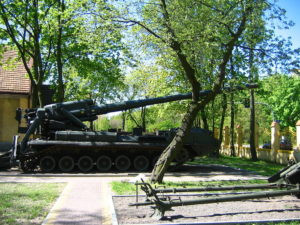Russia has operationalized the 2s7 Pion, a formidable large-caliber artillery system, in the ongoing conflict in Ukraine. This move signals a significant development in Russia’s artillery strategy, aligning with previously announced plans to bolster its artillery force structure. The deployment of the 2S7 Pion highlights Russia’s adaptation and evolution of its military capabilities in response to the challenges encountered in the Ukrainian theater.
The 2S7 Pion stands as the Russian military’s largest self-propelled gun, boasting a 203-mm caliber. These heavy artillery systems are being retrieved from storage, undergoing modernization, and subsequently integrated into Russian ground forces artillery units. This revitalization aims to enhance their range and accuracy, particularly in counterbattery operations. Originally conceived during the Cold War to deliver tactical nuclear payloads against NATO forces, the 2S7 Pion is now being repurposed for long-range conventional fire support in Ukraine.
Historical Context: The 2S7 Pion and Soviet Artillery Doctrine
During the Soviet era, large-caliber artillery systems like the 2S7 Pion held a crucial role in military strategy. They were primarily employed to strike critical enemy infrastructure, including lines of communication, command headquarters, tactical nuclear weapon sites, and logistical hubs. Furthermore, these systems were instrumental in the devastating “rubbling” of urban areas, showcasing their immense destructive power. The dual-use nature of the 2S7 Pion, capable of delivering both conventional and tactical nuclear munitions, underscored its strategic importance in the Soviet arsenal. However, with the Cold War’s conclusion and the shifting geopolitical landscape, the necessity for long-range tactical nuclear artillery diminished, leading Russia to place these powerful systems into long-term storage.
 2S7 Pion
2S7 Pion
Revival and Modernization: Russia’s Strategic Shift Towards Heavy Artillery Brigades
A notable shift occurred in December 2022 when Russia declared a substantial expansion of its heavy artillery capabilities. This announcement included plans to re-establish artillery divisions and brigades, mirroring the organizational structures prevalent during the Soviet era. Soviet artillery divisions historically incorporated brigades rather than regiments, with heavy artillery brigades reporting to their respective artillery divisions. In a typical Soviet-era configuration, each heavy artillery brigade consisted of two battalions equipped with 2S4 Tyulpan 240mm mortars and two battalions with 2S7 Pion artillery. Each battalion comprised four batteries, and each battery operated four artillery pieces. It’s important to note that these brigades were primarily administrative units, with battalions or firing batteries typically integrated into combined arms armies’ artillery groups for operational deployments.
Russia’s current strategy aims to establish five heavy artillery brigades, slated to be equipped with either the 2S7 Pion or its modernized variant, the 2S7M Malka self-propelled guns. Reports indicate that these ambitious plans are progressing steadily. The Malka represents an upgraded version of the 2S7 Pion, boasting an improved rate of fire, increasing it from 1.5 to 2.5 rounds per minute. Satellite imagery captured in early 2024 revealed the movement of 2S7 Pion systems from long-term storage facilities. Open-source reports corroborate this, highlighting the removal of approximately 80 2S7 Pion systems from the 94th Missile and Artillery Arsenal near Omsk, Russia, during this period. These reactivated systems are reportedly being allocated to the newly forming 17th Brigade in Russia’s Leningrad region, suggesting a prioritized deployment to strengthen artillery capabilities in key strategic areas.
2S7 Pion in Action: Deployment and Operational Use in Ukraine
While Russia maintains secrecy regarding the precise organizational structure and command and control frameworks for these new 2S7 Pion formations, artillery divisions, and heavy artillery brigades, historical data offers some insight. Within brigades, these systems were traditionally organized into battalions, each comprising 8-12 artillery pieces, typically distributed across 2-3 batteries per battalion. Given the significant force structure adjustments Russia has implemented since the onset of the Ukraine conflict in 2022, the long-term viability of these adaptations remains uncertain beyond the current conflict.
Despite the ambiguities surrounding the future configuration of Russia’s heavy artillery formations, substantial evidence confirms the operational deployment of 2S7 Pion systems in Ukraine, primarily in support of counterbattery fire missions. Observations in Ukraine have noted 2S7 Pion systems operating in dispersed formations, often in two-gun detachments, with firing positions in close proximity, sometimes less than 20 meters apart. Alongside 220-mm and 300-mm multiple-rocket launchers and ZALA Lancet loitering munitions, the 2S7 Pion has played a crucial role in Russia’s counterbattery efforts, aiming to neutralize Ukrainian artillery threats.
Addressing Shortcomings: Why Russia Relies on the 2S7 Pion in Ukraine
The utilization of the 2S7 Pion in counterfire roles may stem from limitations in the range, accuracy, and ammunition availability of Russian 152-mm howitzers when compared to the advanced Western 155-mm artillery systems supplied to Ukraine. While Russia’s standard 152-mm howitzer has a range of approximately 17 kilometers, the 2S7 Pion significantly outranges it with a 40-km range. However, the 2S7 Pion is less agile, particularly in rapid counterbattery scenarios. Conversely, the upgraded 2S7M variant incorporates an enhanced fire-control system, offering improved accuracy compared to the standard 152-mm howitzer. The 2S7M is operated by a crew of 14 soldiers and carries eight rounds of ammunition, whereas the original 2S7 Pion has a crew of seven and carries only four rounds onboard; the remaining crew and ammunition are transported in an auxiliary vehicle. Reports from Russian artillery crews suggest that the deployment of the 2S7 Pion in counterbattery roles may also be attributed to delays in fielding the more advanced 2S35 152-mm Koalitsiya-SV self-propelled howitzer, which is intended to be a next-generation artillery system.
Evolving Russian Fires Capabilities and Strategic Implications
Russia’s fire capabilities have demonstrably evolved throughout the Ukraine conflict, reflecting a continuous process of learning, adaptation, and innovation to overcome operational challenges. The strategy of upgrading legacy equipment like the 2S7 Pion and integrating it with newer organizational and material capabilities has enabled Russia to augment its long-range fire power and develop alternatives to address shortages in precision munitions. This convergence of capabilities has significantly enhanced the versatility and effectiveness of Russian artillery formations in the ongoing conflict.
Implications for the U.S. Army
The operational deployment of the 2S7 Pion and Russia’s broader artillery modernization efforts carry significant implications for the U.S. Army:
- Fires Centrality: The Ukraine conflict underscores the continued centrality of fires in modern warfare and Russia’s success in Ukraine heavily relies on artillery. Russia is adapting its artillery brigades based on lessons learned from large-scale combat operations. This observation is crucial for the U.S. Army, especially considering China, a pacing threat, is closely monitoring Russia’s operational adaptations. These changes will influence how the U.S. Army approaches artillery doctrine, organizational structures, training methodologies, leadership employment of fires, sustainment of CLASS III and V supplies, and the forward maintenance of tube and rocket artillery systems under sustained high-volume fire missions.
- Logistical Challenges: The high expenditure of all classes of supply and the vulnerability of logistics nodes in large-scale combat operations pose significant sustainment challenges for the U.S. Army. Integrating fires interdiction of logistics into home station and Combat Training Center (CTC) sustainment exercises will better prepare U.S. artillery units and sustainment trains for the realities of enduring large-scale conflicts.
- Rapid Adaptation and Innovation: Prevailing in 21st-century large-scale combat operations necessitates rapid adaptation and innovation. Emphasizing leaders’ ability to adapt and innovate during training exercises and CTC rotations will enhance the U.S. Army’s preparedness for the dynamic and demanding realities of enduring large-scale conflicts.
In conclusion, the redeployment of the 2S7 Pion by Russia in Ukraine is not merely a reintroduction of Cold War-era hardware, but a strategic adaptation reflecting the evolving dynamics of modern warfare and highlighting critical lessons for contemporary military forces, particularly the U.S. Army.

